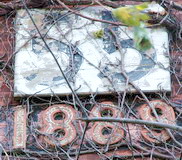| Fort Slocum: Village on an Island |
|
New arrivals and casual visitors to Fort Slocum in its last decades often felt they were on a college campus rather than a military post. The landscape was neat and manicured, and many of the relatively modest brick and wood-frame buildings were clad in ivy. Long Island Sound surrounded the post, and while military etiquette and ceremony were ever-present, there were few weapons for fighting wars in evidence.
When Fort Slocum closed in 1965, it contained around 80 buildings. There were other facilities as well: two piers, a seawall, a system of roads and paths, utility enclosures, a monument, a parade ground, an athletic field, tennis courts, wading pools, playgrounds, trailer park and two abandoned fortifications.
The buildings had been constructed over a span of about 80 years, beginning in 1878 and extending to around 1955. They reflected the post’s varied military missions during this period and also expressed developments in American architecture and culture, as interpreted by Army officers, engineers and architects.
… it was something about it being out in… [Long Island] Sound. You’d get that mist; you’d get that fog, the foghorn. You could hear the water. It didn’t matter where you were on the island, you could hear the waves. And if it was stormy, you could hear that. And it was magical—because it’s so small, and you’re out in the middle of this water.” —Carla Cain, daughter of Col. Frank Castagneto, Fort Slocum’s commanding officer, 1961-1964 (interviewed 2007) |






 cm160.jpg)

